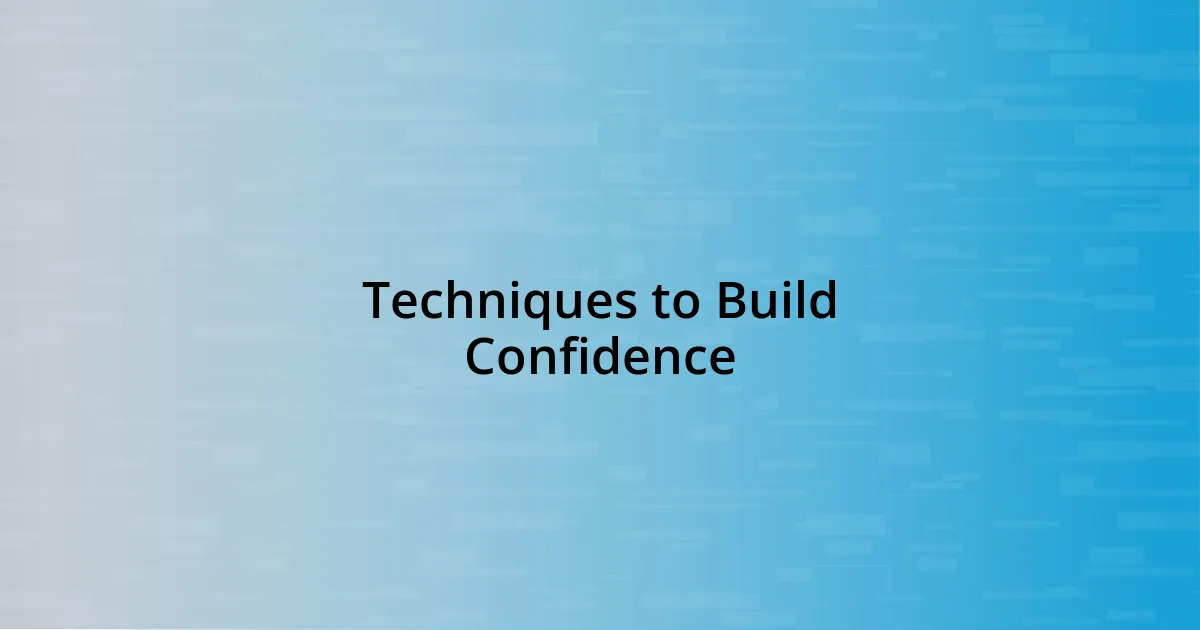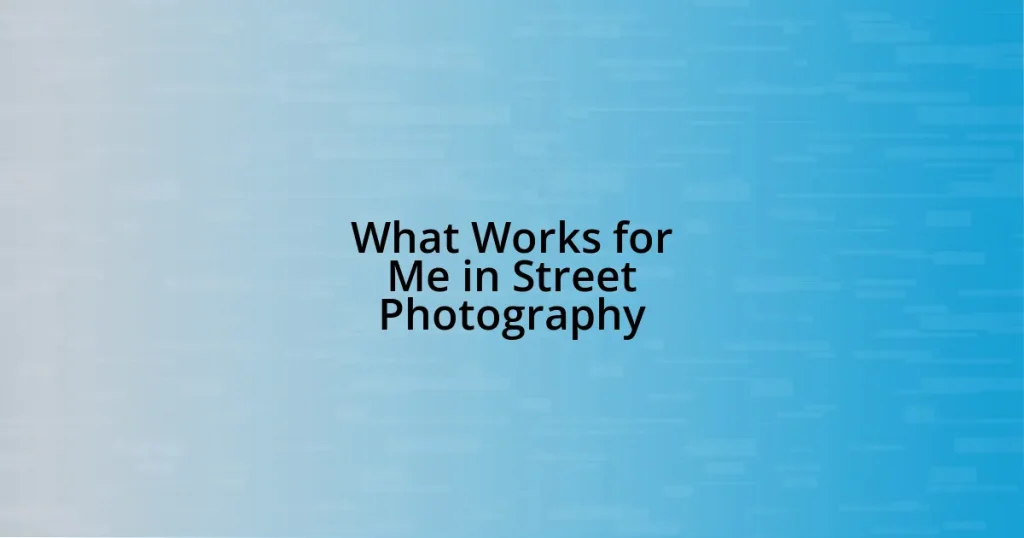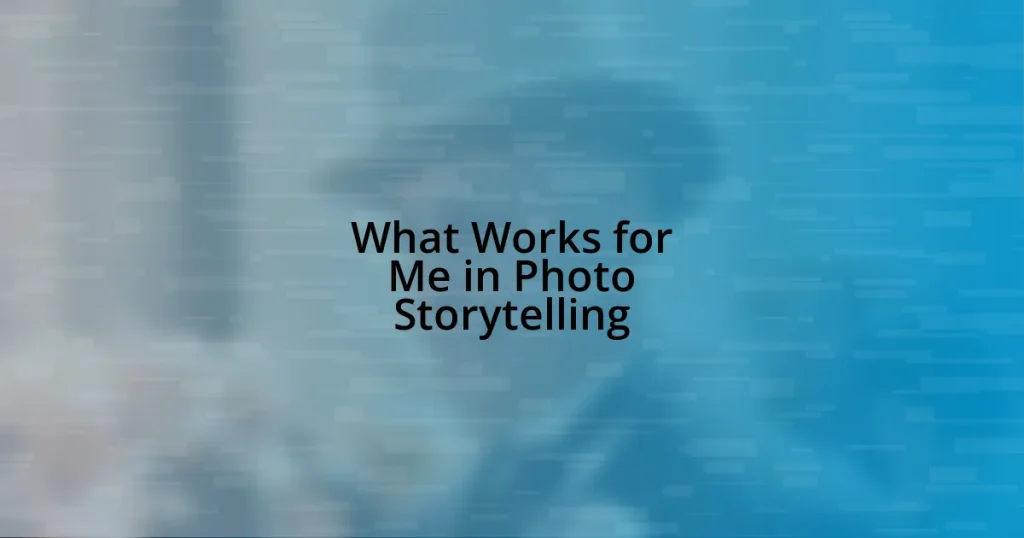Key takeaways:
- Fear in photography often stems from self-doubt and the perception of judgment, but facing these fears can lead to personal growth and artistic development.
- Identifying personal triggers for fear, such as unfamiliar settings, past experiences, and life stress, helps in managing and overcoming anxiety related to photography.
- Developing confidence can be achieved through practical techniques like setting achievable goals, seeking feedback, and embracing mindfulness during shoots.
- Embracing mistakes as learning opportunities fosters growth and improvement, transforming fear of failure into a catalyst for creative evolution.

Understanding Fear in Photography
Fear in photography can take many forms, whether it’s the anxiety of approaching strangers for a candid shot or the daunting task of snapping the perfect picture in a once-in-a-lifetime moment. I’ve often found myself battling that very hesitation, standing behind the lens, feeling paralyzed by the fear of judgment or failure. Isn’t it fascinating how a simple camera can evoke such strong emotions?
I vividly remember a time when I was attending a bustling street festival. I noticed an incredibly vibrant scene unfolding—a child laughing, balloons flying, and colors dancing. But instead of capturing that joy, I hesitated, gripped by the fear of not doing it justice. I realized that my fear was less about the camera settings and more about my confidence as an artist. It’s moments like these that make me wonder: what stories am I missing out on simply because I let fear hold me back?
It’s crucial to understand that this fear often stems from self-doubt or a concern over how others will perceive our work. In my experience, embracing those feelings can actually lead to growth. I remember pushing myself to take that shot despite my fears, and the elation of seeing the final image made every ounce of anxiety worth it. Have you ever felt that way? It’s in those moments that we truly begin to understand our relationship with fear and how it impacts our craft.

Identifying Personal Triggers for Fear
Identifying personal triggers for fear is an essential step in combating it. For instance, I’ve noticed that my fear often peaks in unfamiliar settings. A trip to a new city was particularly daunting for me; I remember walking through crowded streets, feeling the weight of my camera like a heavy anchor. The fear of missing those fleeting moments because I hesitated to take shots consumed me. It was here that I recognized the importance of pinpointing these specific situations, as awareness helps diminish the grip of fear.
Sometimes, I realize that my triggers can be tied to past experiences. For example, during my first photography class, I nervously presented my portfolio, and the critical looks from peers left me rattled. I’ve come to understand that this memory was a trigger that lingered, fanning the flames of my insecurities whenever I had to share my work again. Each time I faced similar scrutiny, the fear would rise, but reflecting on it helped me break that cycle—turning past discomfort into stepping stones for growth.
Moreover, I find that stress levels can amplify fear. If I’m already feeling overwhelmed in life, the thought of engaging with my camera can feel insurmountable. I recall a particularly stressful week when I decided to escape to nature with my camera. Initially, the idea of capturing serene landscapes felt like a chore. However, once I settled in and allowed myself to breathe, I discovered a comforting truth: the act of photography itself became a stress relief rather than a source of fear. Recognizing how external pressures influence my mindset has been transformative.
| Trigger | Personal Insight |
|---|---|
| Unfamiliar settings | Feeling overwhelmed and hesitant to capture spontaneous moments. |
| Past experiences | Critical feedback shapes my fears, but understanding this helps me move forward. |
| Life stress | Stress can affect my willingness to engage with photography, but it can also offer relief when I push through. |

Techniques to Build Confidence
Building confidence behind the lens is crucial for any photographer who wants to capture authentic moments. One technique I’ve found effective is practicing regularly, even if it feels daunting. I started a 30-day photography challenge where I committed to taking at least one photo daily. Some days, I would snap mundane things, like a coffee mug or blooming flowers in my garden. But what surprised me was how each little success chipped away at my fear, gradually nudging me toward more ambitious shots.
Here are a few techniques that can help you build confidence behind the lens:
- Set Achievable Goals: Start with small, specific targets, like capturing a sunset or a local event.
- Seek Feedback: Share your work with trusted friends or online communities, embracing constructive criticism to learn and grow.
- Visualize Success: Before a shoot, I often visualize the shots I want to capture. This mental practice helps me approach the moment with more certainty.
- Engage with Your Environment: Spend time exploring your shooting location without the lens. Familiarity can ease anxiety and enhance your comfort level.
- Celebrate Wins: No matter how small, acknowledging your achievement after each shoot can reinforce your growing confidence.
I remember a day when I decided to attend a local art fair. At first, I felt that familiar wave of insecurity, terrified at the idea of approaching artists for portraits. But I brought along a checklist of goals for the day. When I finally started to engage with the artists, it was exhilarating! Each conversation warmed me up, and I left with some incredible shots. It taught me a vital lesson: just stepping out and connecting can lead to newfound courage and creativity.

Practicing Mindfulness Behind the Lens
Practicing mindfulness behind the lens has been a game-changer for me. I often find that taking a deep breath before clicking helps ground me in the moment. I remember one particularly chaotic day at a bustling market; the vibrant colors and loud laughter were overwhelming. Instead of snapping away like usual, I paused, closed my eyes for a moment, and focused on the sounds around me. When I finally opened my eyes, I felt a newfound clarity, enabling me to capture imagery that resonated with the essence of that lively atmosphere.
Engaging fully with my surroundings has made a significant difference. I recall a trip to a quiet beach where the rhythmic sound of waves calmed my racing thoughts. Rather than rushing to take photos, I let myself be present—watching the sunlight dance on the water and feeling the sand beneath my toes. This slower, more intentional approach made every click of my camera feel like a natural extension of my experience. It’s fascinating how embracing the moment can transform not just my photos, but also my mindset.
Mindfulness isn’t just about what we take in; it’s also about how we process it. On days when anxiety creeps in, I ask myself, “What am I feeling right now?” Allowing that awareness to surface is liberating. For instance, after struggling with feelings of inadequacy during a photo walk, I took a few moments to acknowledge my self-doubt. Instead of running from it, I embraced it and used that energy to frame my shots with intention. What if embracing those feelings instead of fighting them led to unexpected creativity? That perspective has shifted the way I approach both my photography and my emotions.

Developing a Supportive Network
Surrounding myself with the right people has truly transformed my photography journey. I recall joining a local photography club that met every month. Initially, I was hesitant, filled with fear about showing my work to seasoned photographers. However, the warmth and encouragement I received were incredible. Their genuine feedback not only boosted my confidence but also provided insights I had never considered before. It’s funny how simply sharing your experiences with others can create a sense of belonging that diminishes fear.
I often think about the days I felt completely alone in my struggles—those internal battles with self-doubt can be overwhelming. Reaching out to friends who understand these challenges has been invaluable. One evening, I shared my apprehensions with a fellow photographer who had faced similar hurdles. Listening to her stories of overcoming fear opened my eyes to the fact that everyone grapples with insecurity at times. This realization made me more willing to take risks in my photography; after all, if she could push through, so could I.
Building a supportive network is about creating a safe space where we can express ourselves. I remember setting up a photo share session with a few close friends and pouring over our images together. As we critiqued each other’s work, laughter and encouragement filled the room. These moments taught me that vulnerability is powerful. It allows us to learn and grow collectively, turning fear into a shared adventure. Who knew that fostering connections could not only ease anxiety but also elevate our creativity?

Setting Realistic Goals for Improvement
Setting realistic goals has been a vital part of my improvement behind the lens. I remember the time I decided to focus on just one aspect of photography instead of overwhelming myself with everything at once. For a month, I dedicated myself to mastering lighting techniques. This small but targeted goal transformed my approach, allowing me to feel more confident with each shot. Isn’t it funny how narrowing our focus can lead to such profound growth?
Another effective strategy I’ve found is to break larger aspirations into smaller, manageable objectives. Instead of aiming to become an award-winning photographer overnight, I set weekly challenges for myself, like experimenting with different camera settings or trying new compositions. One week, I challenged myself to shoot in black and white. That experience not only sharpened my skills but reignited my passion. How often do we find that stepping outside our comfort zone, even in small ways, brings unexpected joy?
The beauty of setting realistic goals is the way they create a roadmap for progress. I still remember celebrating when I achieved my goal of taking a portrait that truly captured my subject’s emotion. It felt gratifying to see my dedication pay off in a tangible way. It made me realize that every small win matters. What if, instead of fixating solely on the destination, we learned to appreciate each step along the journey? That mindset has been crucial for me, fueling my continuous growth behind the lens.

Embracing Mistakes as Learning Opportunities
Embracing mistakes has been a game changer in my photography journey. I vividly remember the first time I shot a wedding. I was so nervous that I missed several key moments because I was afraid of making errors. But looking back, those “mistakes” taught me invaluable lessons about timing and anticipation. What if I had let that fear stop me? Instead, I learned to view mistakes as stepping stones rather than setbacks.
Every time I missed a shot or miscalculated the lighting, I found myself reflecting on what went wrong. I began to keep a journal, documenting each blunder along with its lesson. One evening, I stumbled across an old entry about a poorly framed sunset. Instead of cringing, I smiled, recognizing how much my eye for composition has sharpened since then. Isn’t it fascinating how mistakes can carve pathways to improvement? By embracing them, I turned my fear into a catalyst for growth.
Now, I actively seek out challenges that push my limits, fully aware that mistakes are just a part of the process. I think back to a photo project where I experimented with long exposure techniques. My initial attempts were far from perfect, yet each failure made my eventual successes that much sweeter. I’ve learned that the fear of failure can be overshadowed by the joy of discovery. So, why not embrace mistakes as a crucial part of our creative evolution? After all, every click of the shutter is an opportunity to learn and grow.
















